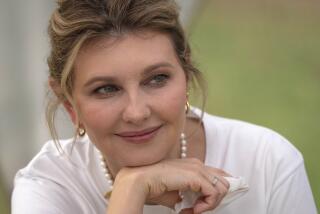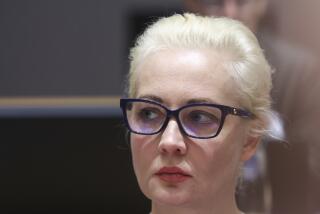She Tours Opulent Leningrad Palaces : Czarist Relics Enlighten First Lady on Revolution
- Share via
LENINGRAD, Soviet Union — First Lady Nancy Reagan, viewing the opulence and splendor of czarist palaces on a whirlwind tour of Leningrad, declared Tuesday that now she understands why the Russian people rose up in revolution.
Mrs. Reagan gazed wide-eyed at the displays of pre-Soviet wealth, including diamond-encrusted blankets for royal horses and the jewel-topped snuff boxes of Catherine the Great.
She made it clear that she has no sympathy for the communist system. “Their philosophies and positions,” she said, “are completely different from ours.”
But in answer to reporters’ questions after examining the relics of the czarist era, she said the contrast between the excesses of royal wealth and the lives of ordinary Russians gave her insight into the causes of the 1917 revolution.
“When I saw what they wore on their horses, and then when you went down to the level of the people,” she said, “it gives you an understanding of what happened and why it happened.”
Examining the horse blankets and harnesses decorated with diamonds and emeralds, Mrs. Reagan’s press secretary, Elaine Crispen, quipped, “For the ranch.” The First Lady agreed, going along with the joke, but then shook her head and commented: “I just don’t believe it.”
In a question-and-answer session with reporters, Mrs. Reagan was asked about her hostess for the five-hour Leningrad visit, Lidiya Gromyko, the wife of Soviet President Andrei A. Gromyko.
“She’s nice, very friendly and warm,” Mrs. Reagan said.
She was then asked to compare Mrs. Gromyko as a tour guide with Raisa Gorbachev, the wife of Soviet leader Mikhail S. Gorbachev. The First Lady laughed and paused as she groped for an answer, then said, “Well . . . everybody’s different.”
A reporter asked if Mrs. Gromyko lectured as much as Mrs. Gorbachev, a former college professor who has been described as sometimes speaking as though she were laying out material for students taking notes. Mrs. Reagan laughed uproariously at the question and said: “I’m desperately trying to think.”
Raisa Gorbachev Not on Tour
Mrs. Gorbachev did not accompany her to Leningrad, and Mrs. Reagan appeared to pay little attention to Mrs. Gromyko on the tour.
In the course of the First Lady’s highly compressed visit, scores of thousands of people lined the streets as her motorcade passed through the former imperial capital, once known as St. Petersburg, although there had been no advance word of the route she would take.
Soviet spectators, many waving in greeting, stood three or four deep on the main shopping street, Nevsky Prospekt, as her limousine passed slowly by. Store clerks, bakery workers in white smocks, soldiers and sailors joined the throngs.
“Wasn’t that wonderful!” the First Lady said later. “I was waving, hoping they would notice.”
The American consul general in Leningrad, Edward Hurwitz, said he was impressed by the turnout. “They were warm,” he said of the people here. “They weren’t dragooned into coming. They were really very curious.”
Visits War Memorial
Mrs. Reagan, wearing a lemon-yellow two-piece suit, stopped first at a memorial to the people who defended Leningrad in the 900-day siege of World War II by German invaders. She entered a dark, tomb-like museum where she was told how 650,000 people died from cold and starvation during the siege.
She signed the guest book and placed flowers at a monument, and a guide told her: “The Soviet Union was victorious . . . but there were no smiles. It was a victory with tears in the eyes. So much was lost.”
Mrs. Reagan made a lightning tour of the Hermitage, which contains one of the world’s great collections of paintings, drawings and engravings, in all more than 54,000 works in addition to other forms of art. Mark Nechayev, a senior expert at the museum, kept up a running commentary in English while the rest of the First Lady’s retinue, including the puffing Mrs. Gromkyo, tried to keep up.
“Very fast, very fast,” Mrs. Gromyko exclaimed at one point. “So quick. They stand. They go.”
Under Lock and Key
In a matter of minutes, Mrs. Reagan inspected a Rembrandt, two Leonardo da Vincis and countless other objects. Of the hour Mrs. Reagan spent at the Hermitage, 10 minutes were spent in the Golden Treasury Room, where some of the most valuable items are kept under lock and key.
At one point she clapped both hands over her eyes and said, “Oh, so much to see!”
After a pause for tea, the tour was resumed, causing a Soviet official from Moscow to mutter that a proper visit to the Hermitage would take a month. “It’s a crime the way they’re doing it,” he said.
Mrs. Reagan’s guide, asked how long it should take to see the Hermitage, replied diplomatically: “It depends. Sometimes life is very short. Once people lived for only 25 years, and they had to experience everything in that time.”
After visiting the Winter Palace, where the Bolsheviks seized power in 1917, Mrs. Reagan traveled by hydrofoil on the Neva River to the summer palace built by the founder of the city, Peter the Great, in the early 18th Century.
On board, Mrs. Reagan sat next to Dmitri Likhachev, an authority on Russian culture. They conversed about the high-rise apartment buildings along the river.
View of ‘Monstrosities’
Likhachev said he felt they were too impersonal, and she agreed. “What are we going to do about all those monstrosities?” she said. Likhachev proposed the development of a low-rise city, stretching from Leningrad to Moscow, with single-family homes for the most part.
At the ornate summer palace, known as Petrodvorets in Russian, Mrs. Reagan threw several coins into a fountain and made a wish. Mrs. Gromyko said this means that the coin thrower will return. Mrs. Reagan refused to divulge her wish, on grounds that if she did so it would not come true.
“It was just overwhelming,” she said when the tour was over. “I wish I could go back and really see it.”
More to Read
Sign up for Essential California
The most important California stories and recommendations in your inbox every morning.
You may occasionally receive promotional content from the Los Angeles Times.













